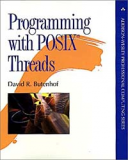Книга: Programming with POSIX® Threads
1.2.2 Concurrency
1.2.2 Concurrency
Concurrency, which an English dictionary will tell you refers to things happening at the same time, is used to refer to things that appear to happen at the same time, but which may occur serially. Concurrency describes the behavior of threads or processes on a uniprocessor system. The definition of concurrent execution in POSIX requires that "functions that suspend the execution of the calling thread shall not cause the execution of other threads to be indefinitely suspended."
Concurrent operations may be arbitrarily interleaved so that they make progress independently (one need not be completed before another begins), but concurrency does not imply that the operations proceed simultaneously. Nevertheless, concurrency allows applications to take advantage of asynchronous capabilities, and "do work" while independent operations are proceeding.
Most programs have asynchronous aspects that may not be immediately obvious. Users, for example, prefer asynchronous interfaces. They expect to be able to issue a command while they're thinking about it, even before the program has finished with the last one. And when a windowing interface provides separate windows, don't you intuitively expect those windows to act asynchronously? Nobody likes a "busy" cursor. Pthreads provides you with both concurrency and asynchrony, and the combination is exactly what you need to easily write responsive and efficient programs. Your program can "wait in parallel" for slow I/O devices, and automatically take advantage of multiprocessor systems to compute in parallel.
- 3.4.4. Concurrency Control
- Chapter 14: Modularizing An Application For Concurrency
- 5.6 Synchronization, Communication, and Concurrency
- 10.3.2 Hardware Concurrency and Service Request Management
- 14.3 Guidelines and Recommendations for Identifying Concurrency
- 14.3.1 Units of Concurrency
- 1.2.6 Concurrency control functions
- 1.6.2 Concurrency
- 10.1.3 Set concurrency level
- Timestamp request
- 5.1 Introduction




